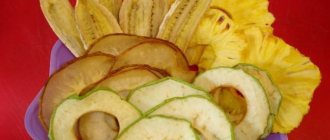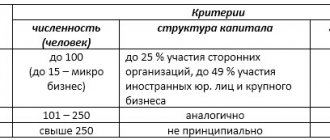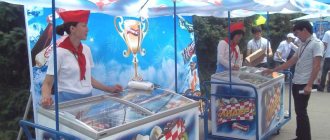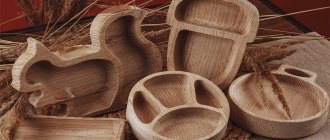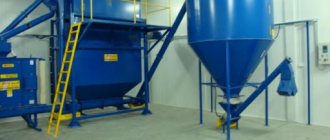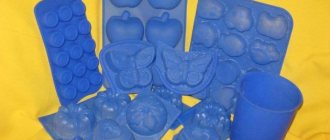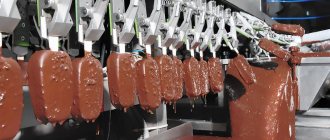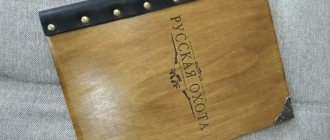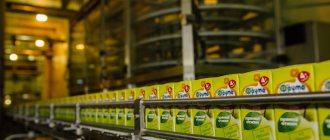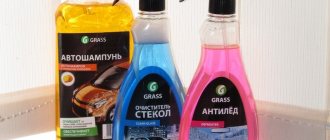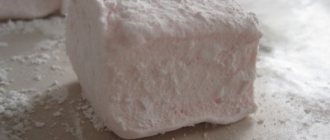Organizational aspects
There are two options available as an organizational form: individual entrepreneur or LLC. We advise you to give preference to the latter . Registration of an LLC requires more time, but the owner receives a number of advantages: the possibility of re-registration or sale, higher authority among buyers.
To start a workshop you will need a large package of documents. If you do not have experience in this type of business, it is better to hire a lawyer.
The activity falls under the following OKPD codes:
- sesame: 1543400;
- peanut: 1543430;
- sunflower: 1543410;
- nut: 1543420;
- combined: 1543440.
Requirements for the production of sweets are regulated by GOST 6502-2014 . Product quality is regulated by Rospotrebnadzor.
Indian carrot recipe
Indian halva includes original amazing combinations that are made on the basis of khoya. This is specially dried cottage cheese called “ricotta” with milk powder and butter with various additives. We will look at a recipe for Indian carrot halwa, which contains nutmeg and double cardamom.
Ingredients:
- Walnuts – 9 pieces;
- Cardamom beans – 10 pieces;
- Khoya – 90 g;
- Carrots – half a kilo;
- Sugar – 400 g;
- Cardamom – 10 g;
- Ground nutmeg - a pinch (as a substitute - 4 small spoons of cinnamon).
Cooking diagram:
- The homemade halva recipe starts with peeling the carrots. Next, grate it on a fine grater. But the grater should not be very fine so that the carrots do not turn into puree;
- Simmer the vegetable in a dry frying pan to remove excess moisture;
- Add granulated sugar to the dried carrots;
- Clean the cardamom seeds;
- Add all the spices (cardamom powder and grains, ground nutmeg) to the sweet carrot mixture, mix everything thoroughly;
- After the sugar has completely dissolved, add the khoya you prepared yourself;
- On a small flame, knead the Indian delicacy until smooth, place into portioned molds;
We use walnut halves as decoration. Serve with milk or tea.
Premises and staff
First, we rent a workshop. Requirements for it: area from 250 m2, electricity 380 W, hot and cold water supply, heating.
Compliance with sanitary standards is a prerequisite . This compliance is regulated by Sanitary and Epidemiological Supervision. The basic requirements for workshops producing food products can be found on the Rospotrebnadzor website.
It is necessary to provide several zones in the room : for preparing raw materials, for processing and mixing them, for packaging and packing. It would be good if it had a staff room and a kitchen.
Staff
For normal operation of the enterprise, a minimum of 5 people will be required: 2-3 workers, a technologist, and a packaging foreman. If you need an accountant, we hire one. The cleaner may come, for this you can use the services of a cleaning agency.
Semolina halva
This sweetness will especially appeal to little children who do not like semolina porridge. The dessert is not only tasty, but also very healthy.
Before considering the recipe for semolina halva, pay attention to the choice of the cereal itself. Coarsely ground products are best. This is indicated by the letter “T” marking on the packaging.
You need to prepare:
- Water – 3 glasses;
- Olive oil – half a glass;
- Unrefined sugar – 2 cups;
- Semolina - a glass;
- Chopped sweet almonds - a quarter cup;
- Walnut (kernels) – 1/8 cup;
- Ground cinnamon - 1/8 teaspoon.
Cooking at home:
- Place the semolina and ground almonds in a dry saucepan, put it on gas and fry a little until the cereal acquires a light brown tint;
- Combine olive oil and brown sugar and add to saucepan. Set the flame to low and constantly stir the mixture until it becomes thick;
- Transfer the sweet mixture into a beautiful bowl (you can use a baking dish) and place it in the refrigerator for at least a couple of hours to harden;
- Transfer the frozen dish to a large plate and sprinkle a mixture of crushed walnuts and cinnamon on top.
Serve this beautiful delicacy to the table, cut it into portions and enjoy its delicate taste.
Raw materials for the production of halva
To make the delicacy we use:
- The basis. This includes nuts or seeds, molasses and sugar.
- Foaming agent. Gives the product the desired consistency, includes: licorice extract, egg white, soap root.
- Filler. Depending on the recipe, this includes: aromatics and dyes, candied fruits, dried fruits, whole hazelnuts, peanuts or almonds, sunflower seeds, cocoa.
Buy ingredients from trusted wholesalers . Give preference to domestic companies: this way you will save on transportation and receive timely delivery.
Stages of making halva
The following stages are present in the production of halva:
- preparation of protein mass from seeds;
- cooking caramel;
- obtaining soap root extract;
- mixing the extract with caramel;
- thoroughly knead the resulting mass.
Basically everything. But let's take a closer look at this whole process. And at the end you will find a video where they will show you everything in detail.
First stage
To prepare the protein mass, you first need to prepare the seed. To do this, the grains are thoroughly cleaned and dried. After cleaning, the seeds will have a thin film (seed coat), which is removed at the seed vines. Next, the kernels are washed and dried well. At the final stage, they are fried to a certain degree and crushed until a homogeneous mass is obtained. At the first stage of production, the basis of the future product is prepared.
Second stage
An important ingredient for preparing halva is properly prepared caramel. It must be plastic and not subject to crystallization. The high content of molasses in the caramel mass helps ensure such qualities. The syrup is cooked in a special vacuum apparatus.
Third stage
At the third stage, a foaming agent (decoction of soap root) is prepared. Boil the root and boil it down to an extract with a density of 1.05. Next, the finished foaming agent is mixed with the caramel mass, which will give the halva a porous structure.
In order for the future product to have a layered fibrous structure, all ingredients must be kneaded several times. To begin with, a foaming agent and caramel mass are placed in the vat and kneaded at low speeds. At the same time, prepared seeds and flavorings are placed in the container. Further kneading occurs with a gradual increase in the speed of the apparatus. The entire kneading time does not exceed 5 minutes. The finished product after passing these stages will have a temperature of about 65-70 degrees.
Halva is a very tasty and original confectionery product. However, it is important to remember that this delicacy does not have a long shelf life. During long-term storage, the surface of the product becomes moist and fat leaks. The quality of halva depends on the correct production technology and storage of the product in a factory or store.
Well, to make it clearer for you, we invite you to watch a video fragment from the Galileo program about how that same sunflower halva is made in production. Enjoy watching.
We hope you liked it, and you will definitely join our public page on VK to always be aware of new interesting facts and events from webfacts.ru. Also, be sure to read the article about how crab sticks are produced. We are sure that
Equipment for the production of halva
Even a small halva production line requires the purchase of special devices and apparatus.
Basic equipment list
- mechanism for caramelization;
- crushing and spreading apparatus;
- mill;
- device for roasting nuts;
- container for mixing components;
- packaging machine.
The price is determined by power, manufacturer and level of automation. The most economical option: semi-automatic equipment with a productivity of 100-150 kg/h will cost about $25 thousand .
More powerful and functional equipment will cost 2 times more. Multifunctional machines will allow you to produce different types of halva.
Alternatively, you can save money and buy used. devices. They will cost about 30% less. Good equipment is produced by companies: Russian organization Era LLC, Tronka-Agrotech LLC (Ukraine), ALKE.
Expenses and income
To launch you will need: $25,000 (equipment), $1,500 (premises), $1,500 (salaries), $1,000 (organizational expenses and advertising), $6,000 (raw materials). Initial capital – from $35,000.
The average wholesale selling price of the product is $1.2-2.5 per kg. The cost price is $0.6-1.7 per kg. This means that with the production of 1 ton per day and full sales per month, you can receive a net profit of $3,000.
Payback period from 1 year.
- Investments 3.025 million rubles.
- Monthly revenue 1.056 million rubles
- Net profit 197,885 rub.
- Payback 15.29 month
The purpose of writing a business plan: Assessing the economic efficiency of organizing the production of halva.
Halva production technology
A good product requires detailed elaboration of the recipe. You can use ready-made recipes or develop your own. The latter option requires obtaining permits based on the results of laboratory tests.
Let's look at how halva is made according to the classic recipe:
- Cooking molasses in a caramelizer. To do this, use sugar and water, sometimes adding citric acid.
- Beating egg whites.
- The starting ingredients are fried and crushed.
- Mixing ingredients in a container. Take chopped nuts, molasses and protein. Stir until smooth. Foam is formed in the process.
- Leave to harden according to instructions and package.
The process is quite simple and fully automated.
How to make halva at home?
It's best to make the sweets yourself. Then you will know for sure that there are no additives, but only natural ingredients. There are different recipes, but the principle is approximately the same for all.
To prepare halva from seeds you will need: peeled seeds (3 cups), flour (2 cups), water (200 ml), brown or regular sugar (100 g), vegetable oil (100 ml), vanillin (optional):
- The seeds need to be fried, but without oil, just dry them in a frying pan;
- Afterwards, scroll them in a meat grinder, or grind them in a coffee grinder (this method is more convenient);
- Now lightly fry the flour without oil and gradually add seeds to it;
- In a separate pan, mix sugar, vanillin, water and oil, heat and wait until it boils;
- Once it boils, add the seed mixture and stir;
- Choose a shape, lay paper on the bottom and spread the mixture;
- Place everything in the refrigerator until it hardens.
You can diversify the recipe by adding honey or condensed milk or cocoa to the syrup. You can also prepare it from peanuts, walnuts and others. You can experiment as you wish, inventing your own recipes.
In this article we told you what halva is made from. It turns out that the name is used to describe several types of products. This can be a confectionery product, a vegetable or even a milk mixture. But the most delicious and healthy one can only be made with your own hands, and besides, making it is not at all difficult.
Sales
At the stage when the recipe has been selected or developed, the initial components have been purchased, and the line has been installed, start looking for customers. At first, we recommend starting with small city stores. If everything goes well, you can switch to large regional and federal chains (Pyaterochka, Magnit, Dixie).
Wholesale sales will ensure full sales, so it makes sense to work with legal entities under a contract. To interest a buyer, it is not enough to launch an advertising campaign on the Internet. Connect local TV, radio and advertising banners .
Large food chains rarely seek out customers themselves. It makes sense to contact their purchasing department and send a newsletter with a commercial offer for your product.
Sunflower seed halva
This dish is very high in calories due to the fats, proteins and vegetable fiber that are included in its composition, but in small quantities it is very good for your health.
Product composition:
- Wheat flour – 200 g;
- Boiled water – 125 ml;
- Granulated sugar – 125 g;
- Sunflower seeds – 400g;
- Refined sunflower oil – 125 ml (you can take unrefined for a stronger aroma of seeds in the finished dessert).
Recipe for halva from seeds:
- Fry the peeled seeds in a dry frying pan until golden brown, remembering to stir constantly. Pour them into a bowl and let cool;
- In the same frying pan we repeat this process with flour, it is also fried until golden;
- Grind the seeds in a coffee grinder and mix with flour;
- Then prepare sugar syrup. Pour water into a saucepan and put it on the flame, add sugar. Stir and cook until slightly thickened. Add butter and syrup to the crushed mass;
- Mix thoroughly, place in molds and place in the freezer for 5 hours;
- Next, remove the molds and our food is ready for tea drinking.
Sunflower halva will give you energy for the whole day and the unique taste of fried seeds.
Main structural elements of an automated line
Equipment for the production of halva consists of the following machines and devices: fanning and crushing machines, calibrator, hammer mill, installation for frying and subsequent cooling of nuts and seeds, caramelizer. An indispensable component of any line are baths for kneading halva.
This equipment for the production of halva allows you to produce it in several types: sunflower with different fillings (for example, with raisins), peanut, vanilla and glazed with chocolate.
However, the production process will be incomplete without an automated line responsible for packaging finished products. Again, considering foreign analogues: there the specified line is included in the kit. With the help of this equipment, in addition to packaging, labels are applied. Its cost is about 1 million rubles.
Production scale
Halva is produced in large quantities in workshops with the required equipment. Professional machines prepare caramel, fry and grind the seeds, mix all the ingredients repeatedly, and package the finished product. Despite the fact that the entire process is automated, not a single stage of sweet preparation should be overlooked.
In factories, hundreds and even thousands of kilograms of sweets are prepared. To produce the delicacy, the main component is sunflower seeds, purchased in bulk from the manufacturer. If you calculate the waste of time and money on preparing homemade halva, it will be more expensive than factory-made halva. During the production of each batch of sweets, specialist technologists adhere to a strict recipe, which allows them to produce products with the same taste characteristics and appearance.
Equipment used
In production, halva is prepared using special equipment from foreign or domestic manufacturers. The preparatory workshop contains a bevel and crusher machine, a mill for grinding seeds and an apparatus for roasting them. In the production workshop there are vats for preparing caramel and mixing all the sweet ingredients. The filling department houses packaging machines that place specific pieces of product into branded or regular packaging.
Ingredients
The following ingredients are used as a foaming agent in halva: keyfoil root (soap root), licorice root, egg white and marshmallow root. Often in this sweet you can find dyes, flavors and various flavoring additives. Of course, the use of natural ingredients is encouraged: cocoa powder, vanilla, pistachios and chocolate.
There are differences in the basis for protein mass. Thus, ground sesame is used for tahini halva, ground seeds are used for sunflower halva, and crushed groundnuts are used for peanut halva. You can often find combined halva (an example is tahini-peanut).
Sweets made from cashews, almonds or walnuts are much less common than vanilla. This is due to the fact that the technology for producing halva of precisely these types is characterized by a certain complexity and high cost, which leads to the high cost of the finished product.
Sales of finished products
In the process of forming the cost, it is necessary to take into account that with industrial volumes, a number of employees may be required at least 6 people, including a foreman, a technologist and workers. At some enterprises, the staff also includes managers who are involved in determining markets for finished products. This confectionery product can be sold both through retail chains and wholesale companies that independently supply the goods to grocery stores.
On average, the retail price of halva is over 100 rubles per kilogram. Wholesale sales – from 50 rubles. Based on average prices for raw materials, the cost of halva is about 30 rubles per kilogram.
In total, with monthly sales of at least 20 thousand kilograms, the manufacturer’s revenue will be from 1 million rubles, and the monthly net profit will be 150 thousand rubles. Thus, the payback period for the initial investment will be about two years.
Summarizing the material presented, it should be noted that correctly selected equipment for the production of halva will allow you to get maximum profit in the shortest possible time.
Business registration
A business can be registered as an ordinary individual entrepreneurship; it is simpler and cheaper. However, it is easier to sell products if you have the status of a legal entity, that is, an LLC. Legal entities can work with VAT, and this is important for large clients, such as chain stores. Taxation system: USN (if your status is an individual entrepreneur) or OSNO (if your status is LLC and you need to pay VAT).
Product certification is not mandatory (it has long been abolished), although you will need to obtain a declaration of conformity. This document confirms the quality of the product, i.e., that the product has passed the appropriate laboratory tests. But large retail chains still require a certificate for the product. This document, like the declaration, is obtained from specialized certification centers. It may take more than one month to receive these documents.
